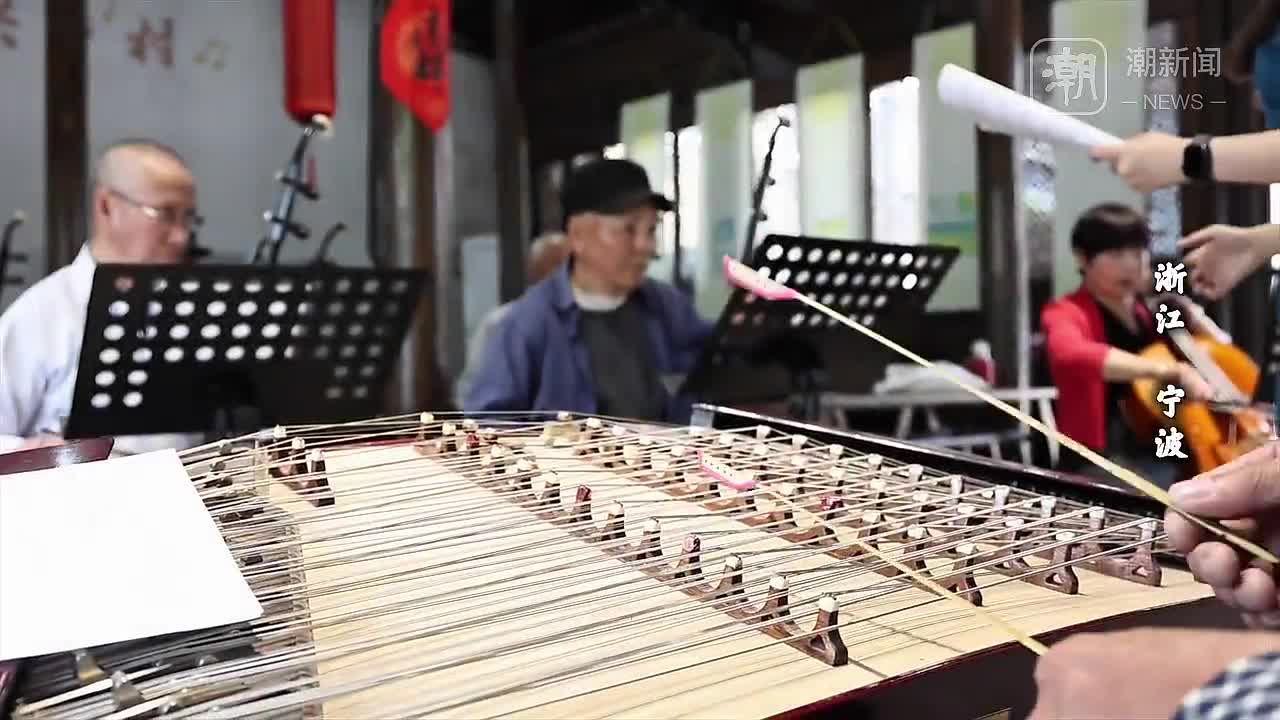
书藏古今,港通天下。宁波是一座向海而生,因港而兴的城市。为了向世界讲好宁波故事,宁波发布推出“双语宁波”栏目,将围绕历史、地理、人文、经济等多个方面聚焦“世界的宁波,宁波的世界”。
作为海上丝绸之路的起点城市之一,宁波自古就和世界各地往来密切。我们跟着宁波晚报“外国档案里的宁波”栏目,带大家换个视角,看看外国档案里的宁波是什么样子?
100多年前,他把“走遍天下,不如宁波江厦”翻译给世界
More Than 100 Years Ago, He Translated the Saying "Traverse the Whole Wide Earth and After All, What Find You to Compare With Ningpo’s River - hall?" to the World.
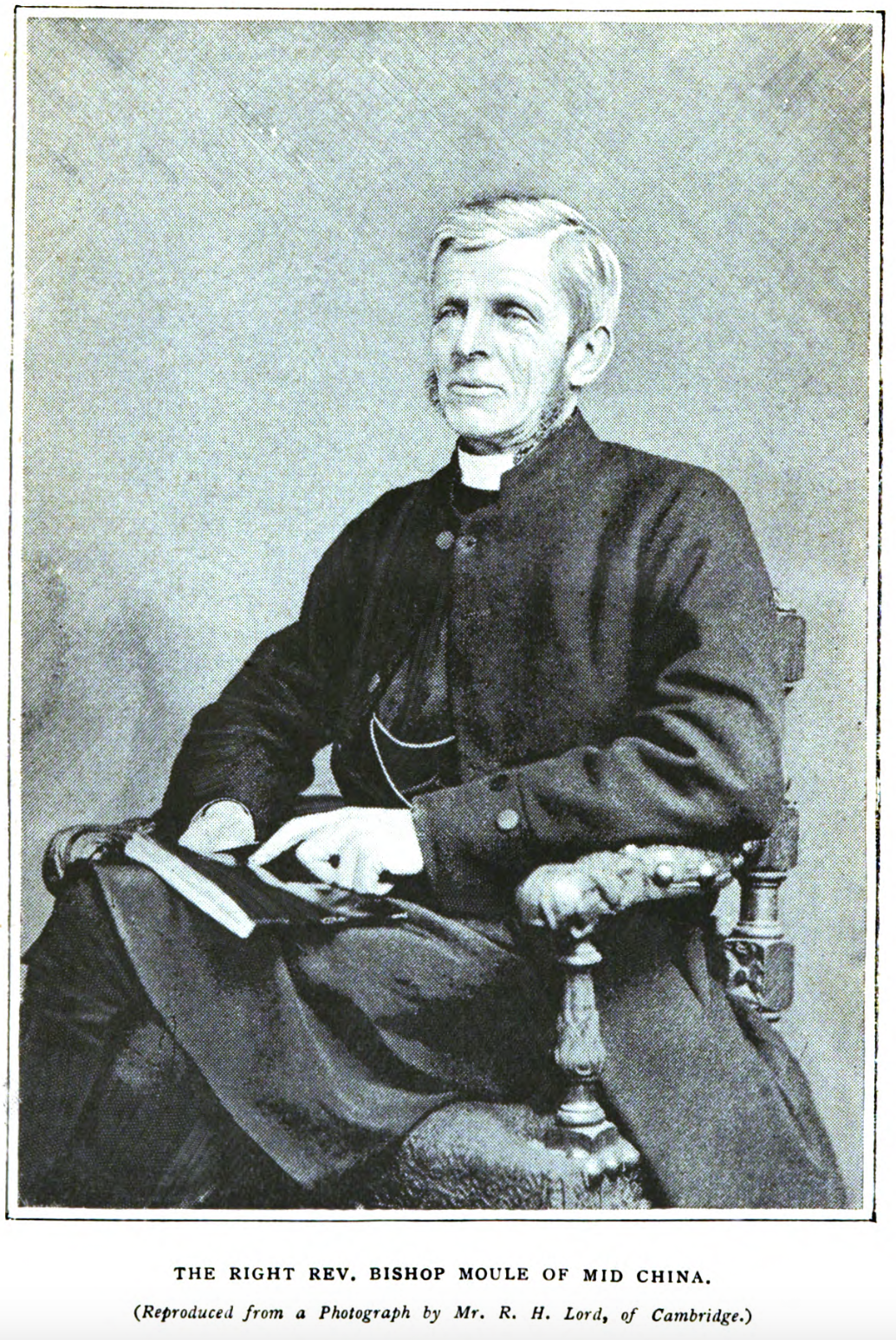
慕雅德照片。
Arthur Evans Moule (1836–1918).
慕雅德,晚清著名来华传教士家族——慕氏家族中的一员。
Arthur Evans Moule (1836–1918), a distinguished member of the renowned British missionary Moule family in China during the late Qing Dynasty.
1861年,他受英国圣公会委派和新婚妻子艾格纳丝一起来到宁波,开启了在中国长达半世纪的生活。宁波是他们停留最久的中国城市,夫妻俩的8个孩子都在宁波出生。
In 1861, Moule was on a mission from the Anglican Church, embarking on a journey to Ningbo with his newlywed wife Agnes. This was the start of their fifty-year stay in China. Ningbo was the place they called home the longest and eight of their children were born here.
在1905年出版的《东亚杂志·第四卷》上,慕雅德在《宁波:古代与现代》一文中,第一次将宁波俚语“走遍天下,不如宁波江厦”翻译给全世界。
In the 1905 edition of East of Asia Magazine, Volume IV, Moule translated and introduced the Ningbo proverb to the world for the first time in his article Ningpo: Ancient and Modern. It is known as “Traverse the whole wide earth and after all//What find you to compare with Ningpo’s river-hall?” (Note: Ningpo, often found in older texts or historical documents, is an earlier romanization of Ningbo.)
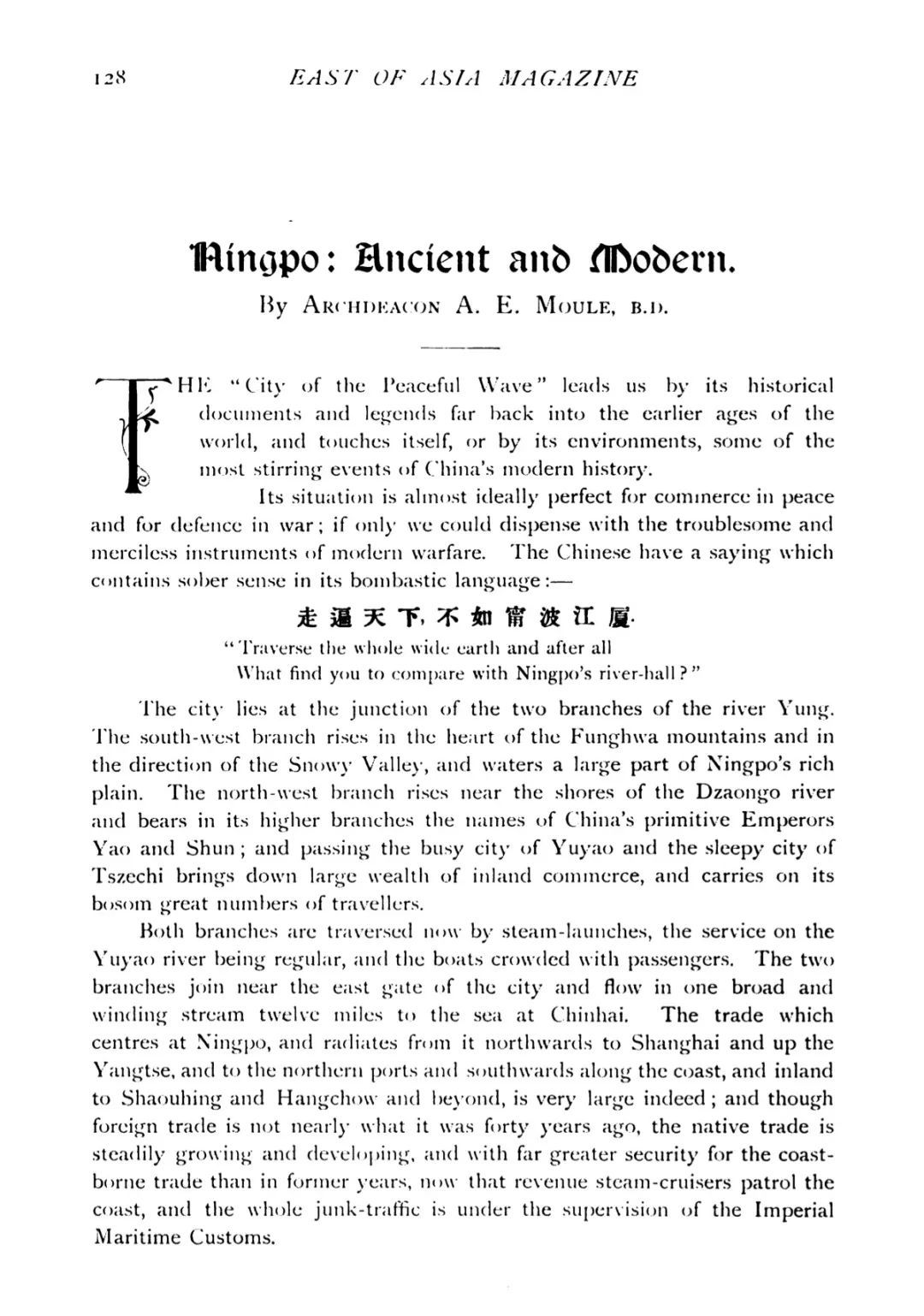
《东亚杂志·第四卷》上,慕雅德翻译“走遍天下,不如宁波江厦”。
Moule translated and introduced the Ningbo proverb to the world: It is known as “Traverse the whole wide earth and after all//What find you to compare with Ningpo’s river-hall?”
在他看来,宁波是“真正意义上4000年历史的缩影,纵横古今”。
In his words, Ningbo encapsulates 4,000 years of history, weaving together the rich heritage of ancient times with the dynamic spirit of modern China.
用文字和画笔刻写宁波
Depict Ningbo with Words and Paintings
1861年至1875年,1902年至1908年,慕雅德一共在宁波生活了二十多年。
From 1861 to 1875, and from 1902 to 1908, Arthur Evans Moule had been living in Ningbo for a total of approximately 20 years.
他对宁波的地理特征、历史古迹熟谙于胸,关于宁波的记录也构成其著作《圣公会浙江传教记事》《新旧中国——三十年的个人回忆和观察》《在华五十年:回忆和观察》中很大一部分。
He was well versed in the landscape character and the historical buildings of Ningbo. His writings on Ningbo form a huge part of his works, including The Story of the Cheh-Kiang Mission of the Church Missionary Society, New China and Old, Personal Recollections and Observations of Thirty Years, and Half a Century in China: Recollections and Observations.
在描述宁波地理位置时,他说:“这座以‘宁静安详的波浪’命名的城市坐落在甬江的两条支流汇合处。其中一条西南流向的支流发源于奉化山的中心地带,指向雪窦山的方向,灌溉着富饶的宁波平原。而另一条西北方向的支流则兴起在姚江的河滨一带,水流最湍急之处以中国古代两位君王——尧和舜命名,她流经繁忙的余姚和鄞县,为当地带来了巨大的财富,她因为自己广阔的胸怀而吸引了许多的旅行者。”
He described that the geographical location of Ningbo — the city of “the Peaceful Wave” — is located between the two tributaries of the Yong River. One of the southwest-flowing tributaries originates from the central area of Fenghua Mountain, pointing towards Xuedou Mountain, and irrigates the fertile Ningbo Plain. While the other northwest-flowing tributary rises along the riverside of the Yao River. The most turbulent part of the water flow is named after two ancient Chinese kings - Yao and Shun. It flows through the bustling areas of Yuyao City and Yin County, bringing great wealth to the local area. Numerous tourists have been deeply fascinated by this area.
慕雅德书中,有很多与宁波城门有关的文字、地图、照片、绘画。
Moule’s books include texts, maps, photos, and paintings related to the city gates of Ningbo.
1906年在《东亚杂志》发表的《太平天国下的宁波》一文,便以1891年《大清国浙江省宁波府城图》为底本,标识了宁波城的城门、灵桥、新江桥与外国人居留地的位置关系。
In the article Ningpo Under the T’ai-P’ings, 1861-1863 published in The East of Asia Magazine in 1906, the positional relationship among the city gates of Ningbo, the Lingqiao Bridge, the Xinjiang Bridge, and the foreign settlement was marked based on the map of the City of Ningbo Prefecture, Zhejiang Province, Empire of the Great Qing in 1891.
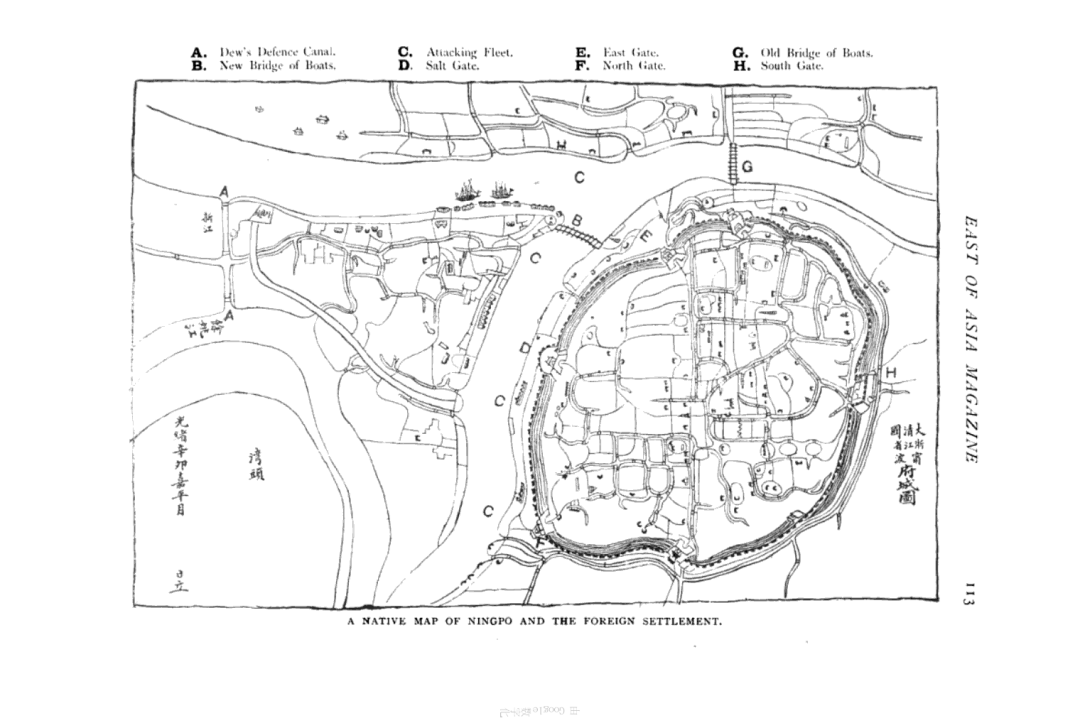
慕雅德标识的宁波地图。
The map published in The East of Asia Magazine.
据慕雅德描述,宁波的古城墙绵延18英里(约29公里),高达25英尺(7.6米),底部宽达22英尺(6.7米),顶部宽达15英尺(4.6米)。
As described by Moule, the ancient great wall of Ningbo stretches over 18 miles (ca. 29 km) with a height of 25 feet (ca. 7.6 meters), a bottom width of 22 feet (ca. 6.7 m), and a top width of 15 feet (ca. 4.6 m).
城门由“两扇木头大门组成,门上覆盖着厚厚的铁皮,前面伫立着巨大的障碍物,同时门上有一把大锁……除了城门外还有大量的水路入口以方便船只进出,不过有时会比城门关得早。水门上有铁闸门,通常只离水面6英尺(1.8米),由于过于低矮,甚至连最小的平底货船都难以通过”。
A city gate consisted of “two wooden gates, covered with a thick iron sheet, in front of which stood a huge barrier, and a large lock on the door ... In addition to the city gates, there are many waterway entrances to facilitate the entry and exit of boats, although sometimes they close earlier than the city gates. The water gates are equipped with iron gates, all of which are usually only 6 feet (1.8 meters) above the water surface. Due to their low height, even the smallest flat-bottomed cargo ships can hardly pass through.”
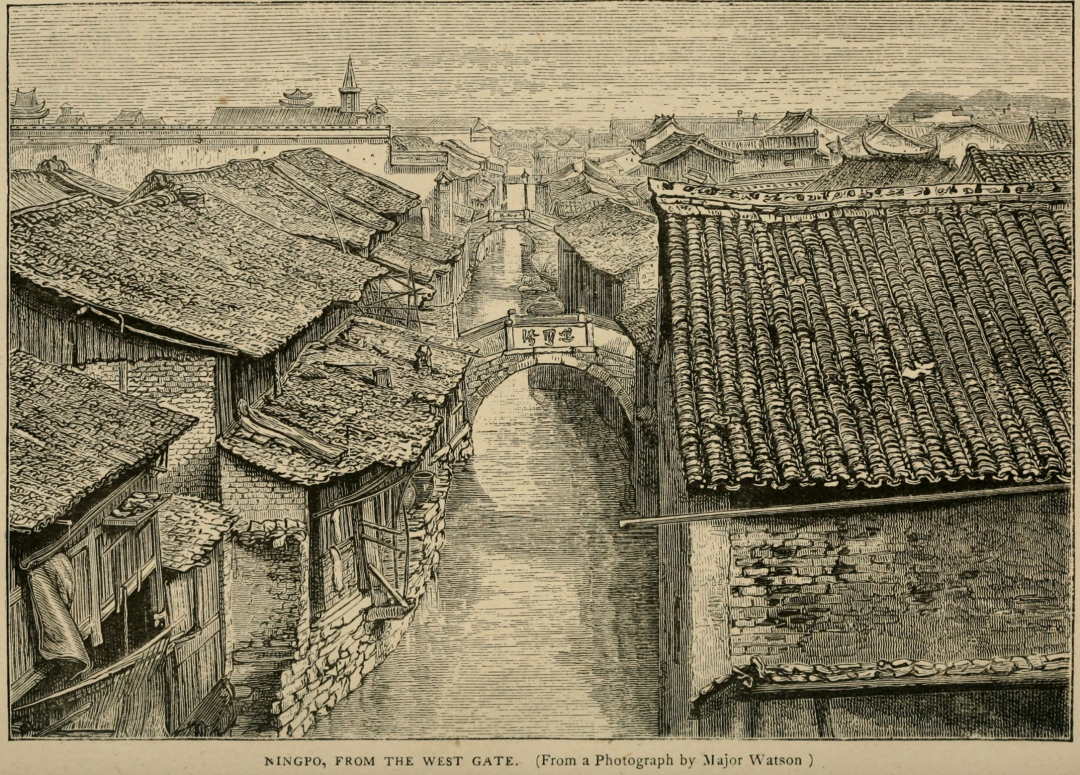
慕雅德根据华生少校照片改绘的“从望京门上看西水关里河”。
An illustration in The Story of the Cheh-Kiang Mission of the Church Missionary Society.
除了勤于撰文,慕雅德还擅长绘画。文中插图除了他本人的速写,还有以照片为蓝本临摹的钢笔画,望京门内的城景、和义门、船只过坝、运河古桥、东钱湖风光、余姚双城……
In addition to his diligence in writing, Moule also mastered painting. Many of the illustrations in the text are pen drawings that he copied based on photographs, such as the city scene in Wangjing Gate, Heyi Gate, the boat crossing the dam, the ancient canal bridge, the scenery of Dongqian Lake, and the twin cities of Yuyao …
今日不可复见的老宁波图景,在他笔下亲切如昨。
The great view of old Ningbo that we can no longer see, is as gracious as yesterday in Moule’s drawings.
一个精通典故的“宁波通”
A well-versed Ningbo-savvy
“走遍天下,不如宁波江厦”是慕雅德翻译的宁波俚语之一。
“Traverse the whole wide earth and after all//What find you to compare with Ningpo’s river-hall?” is one of the many Ningbo proverbs translated by Moule.
事实上,早在1871年,当慕雅德在宁波生活整十年的时候,他就曾出版一本名为《四亿:有关中国和中国人的章节》的文集,其中第七章叫“中国谚语”,是目前所见西方文献中对于宁波谚语最早的系统介绍与翻译。
As early as 1871, Moule published a collection titled Four Hundred Millions: Chapters on China and the Chinese when he lived in Ningbo for a decade. The seventh chapter of the book — “On Chinese Proverbs” — renders the earliest systematic introduction and translation of Ningbo proverbs known in Western literature.
宁波大学人文与传媒学院副教授田力在解读时指出,“当时,慕雅德关于中国的全部知识几乎都来自于宁波,在这本著作里,很多关于宁波的描述,是当时中国城市的缩影”。介绍谚语时,部分还有附有罗马字母拼写的宁波方言读音,“对于后世了解和研究清末宁波流行的俗语和方言,具有重要的语料价值”。
Tian Li, associate professor from the School of Humanities and Communication at Ningbo University, notes that “At that time, Moule’s entire understanding of China was largely shaped by his experiences in Ningbo. In this book, Ningbo stands as a vivid microcosm of China.” Some of the proverbs in the work even include Ningbo dialect pronunciations transcribed in the Latin alphabet, which are “invaluable for comprehending and studying the popular idioms and dialects of Ningbo in late Qing era”.
慕雅德注意到的谚语有几类——一种是从孔子著作中演化移植,如“四海之内皆兄弟也”;有通用的民谚,比如“脚踏两条船”“夫妻本是同林鸟,大难到来各自飞”;以及被他标注为宁波话的“凉亭虽好,弗是久留之地”等等。
Moule categorized the proverbs into several sorts. Some are adapted from Confucian texts, translated as “Within the four seas all are brethren.” Others are common sayings, such as “One foot in this boat, one in that; They both push off, and you fall flat” and “Man and wife, In tranquil life, Sit like birds upon one bough; Trouble comes, They shake their plumes, ‘Sauve qui peut,’ their language now.” Additionally, some proverbs are identified as Ningbo dialect sayings, including “A rest-shed by the weary road, ’Tis good, while blows the cooling breeze; But call it not a dwelling-place, A life-long home for tranquil ease” .
田力指出,1872年,美国传教士汉学家卢公明在上海出版了一部英汉辞典工具书《英华萃林韵府》,第二卷附录中保存了慕雅德整理的“超过两百条的宁波谚语”,均为英汉对照,但略去了拉丁字母拼写的宁波方言读音,“可以说是近代西方文献关于宁波谚语最为全面的收录”。
Professor Tian further remarks that in 1872, American missionary and Sinologist Justus Doolittle published a bilingual dictionary in Shanghai, titled Vocabulary and Hand-book of the Chinese Language. The appendix in its second volume includes over two hundred Ningbo proverbs compiled by Moule, with English and Chinese translations. Despite the fact that the Latin transcriptions of the Ningbo dialect pronunciations are omitted, this collection “remains the most comprehensive Western record of Ningbo proverbs available”.
掌握宁波方言只是慕雅德的才能之一,他还对宁波的很多历史典故和传说了如指掌。《宁波:古代与现代》一文中,他绘声绘色地讲了桃花渡得名的由来“黄晟斩蛟”——
Moule’s expertise extended far beyond mastering the Ningbo dialect. He was also well-versed in Ningbo’s rich history and legends. In his article Ningpo: Ancient and Modern, he vividly recounts the dragon-slaying legend of Peach-flower Ferry.
“古时有恶龙出没,兴风作浪,危害百姓。为了避祸,当地百姓每年向恶龙祭上一双童男童女……黄晟问明原委后,既愤怒又同情,他骑上白马,带上宝剑,潜入海里。龙和黄晟在海里角力,血水交融,把海水染成桃花般的颜色,黄晟和恶龙再也没有出现,此渡口故得名‘桃花渡’……”
The story goes:“In ancient times a dragon used periodically to emerge from the river, and unless appeased by the yearly offering of a boy and a girl it would ravage the banks of the river and terrify the inhabitants ... In the year A.D. 618 a mandarin named黄晟 [Huang Sheng] was on his way up to the city to assume office ... and they told him the sad and weird story. The magistrate’s heart (large as the proverbial heart of the Prime Minister himself, of capacity enough to float a ship), was stirred with compassion and fired with indignation: on his arrival at the spot he mounted a white horse, and armed with a sword made of rushes, he plunged into the river and was seen no more. Neither was the dragon seen from that day forward; only after a commotion of the waters they became dyed as by the colour of the peach-blossom, doubtless with the mingled blood of the dead dragon and of the victorious but dead champion. At nearly the same moment, caused by the dying throes of the dragon, a pool welled up within the bound of the present city, which still remains ...”
他也对“宁波”“四明”“定海”的名字了如指掌。看他的表述,俨然一个“老宁波”“宁波通”在讲故事。
Moule was also intimately familiar with the names “Ningpo”, “Szming” [currently as Siming], and “Tinghai” [currently as Dinghai]. He shared local stories and expressions as though he were a native Ningbo insider.
慕氏家族:架起中西文化交流的桥梁
The Moule Family: Bridging East and West
慕雅德还很喜欢将与宁波发生关联的文人骚客与英国文人作比,以便西方世界快速走进中国文化。
Arthur Evans Moule (1836-1918) was also keen on drawing parallels between Chinese literati associated with Ningbo and their English counterparts, weaving a bridge for the Western world to step into Chinese culture.
在《宁波:古代与现代》中,他说梅辉立(一位英国汉学家)的《中国辞汇》一书中提到“四明狂客”贺知章,他的故事可以跟诺森伯利亚的卡斯伯特尊贵的一生相媲美;也不逊色于惠特比修道院里伴着竖琴吟诗的诗人凯德蒙。他还提到李白,诗人自陇西布衣至朝廷官员,曾经在中国诗坛独领风骚,他命运多舛,曾被贬到云南,最后客死当涂县的采石矶,被宁波人赞誉为“贬谪人间的诗仙”。
In his book Ningpo, Ancient and Modern under the T’ai-p’ings: Confucius (1909), Moule noted that William Frederick Mayers (a British sinologist) referred to He Zhizhang (659-744) as “the madcap of Szming (a metonymy for Ningbo, after its Siming (Szming) Mountain)”, in The Chinese Reader’s Manual (1874). Reflecting on this, he remarked that the life of this bold-styled poet was on a par with the honorable life of Cuthbert, the saint of Northumbria, as well as Caedmon, the Whitby Abbey poet distinguished by “chanting with a harp after a divine dream”. He also acknowledged Li Bai (699-762), a poet who rose from a commoner rooted in ‘extreme West (present-day Gansu Province)’ to become a court official in the highest academy, and who was once a patron of the Chinese poetry world. Undergoing an ill-fated life marked by repeated exiles, he was once relegated to Yunnan, then among the harshest outpost in SW China. His final days, unable to return, ended at Caishiji in Dangtu County of Anhui Province, far away from his hometown. For all the talent and turbulence in his worldly journey, he was honored by the people of Ningbo as “an Immortal banished to earth”
1908年,他在伦敦出版了一本充满童趣的小书《年轻的中国》,介绍中国少年儿童的日常生活,也以宁波经验为蓝本。书中17幅插图,为“四明戴恩泉写”。戴恩泉其人和他的儿子在宁波茶楼酒肆中演奏琵琶卖唱,同时依靠卖画为生。
In 1908, Moule also published a small, interesting book in London, Young China, which described the daily life of Chinese children and teenagers based on his experience in Ningbo. The 17 illustrations in the book are all “specially drawn by a Chinese artist” ― “Matthew Tai” [Dai En’quan] of Siming, who, along with his son, earned a living by playing the pipa in Ningbo’s teahouses and drinking establishments as well as selling paintings.
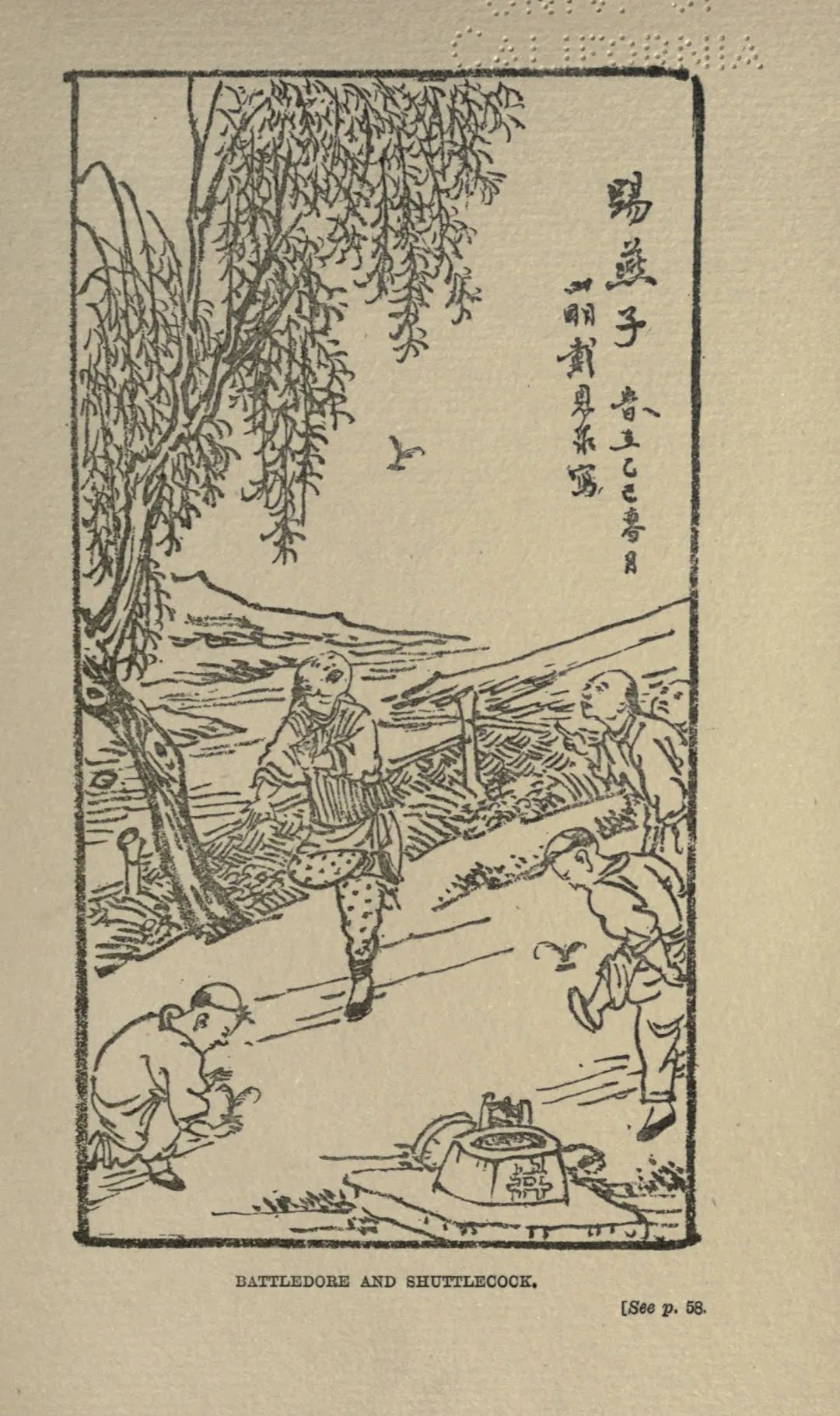
“踢燕子”,出自《年轻的中国》。
An illustration in Young China.
在华五十年,慕雅德也不是一个人在为中西文化交流做贡献——他的哥哥慕稼谷,1858年就被英国圣公会派驻宁波;他的次子慕华德,曾管理宁波三一书院(今宁波第三中学前身)30年,任监院期间,在书院增设算学和地理等学科,使学生习得近代科学知识;其幼子慕阿德,也是世界著名汉学家,是继威妥玛、翟理思之后,剑桥大学的第三任汉学教授;甚至他的夫人艾格纳丝也曾在宁波开设女子圣经班,将沃尔沙姆·豪的著作《中国儿童故事》等翻译成宁波方言,在1866年出版发行。
During his fifty years in China, Arthur Evans Moule was not alone in contributing to the intercultural communication between the East and the West. His elder brother, George Evans Moule (1828-1912) was sent to Ningbo by the Anglican Church in 1858. His second son, Walter Stephen Moule (1864-1949) managed the Ningbo Trinity College (the predecessor of Ningbo No. 3 High School) for 30 years, and during his tenure as superintendent of the school, he introduced subjects such as arithmetic and geography to the curriculum, to enable the students to acquire knowledge of modern sciences. His youngest son, Arthur Christopher Moule (1873-1957) was also a world-renowned sinologist, the third Professor of Sinology at the University of Cambridge, following Thomas Francis Wade (1818-1895) and Herbert Allen Giles (1845-1935). And even his wife, Eliza Agnes Bernau (1842-1925) once opened a girls’ Bible class in Ningbo and translated Walsham How’s (1823-1897) book, Stories for Children (1865), into the Ningbo dialect, which was published in 1866.
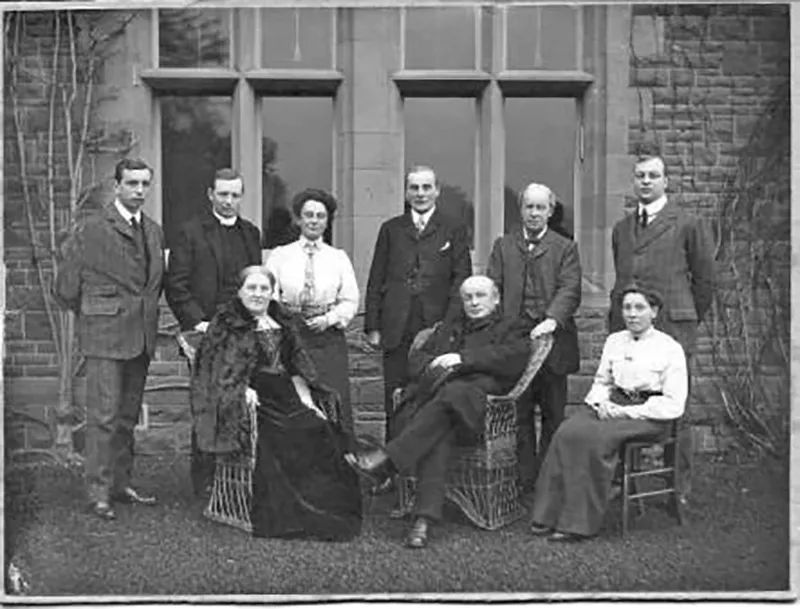
慕雅德(前排右二)与妻子“金婚”合影。
Moule's (the second person from the right in the front row) golden wedding anniversary with his wife.
慕雅德12个孩子中有8个都在宁波出生,家中聘有一位“宁波阿妈”,慕雅德一家叫她苏洛伊斯。1879年,56岁的妇人苏洛伊斯随慕雅德一家回到英国,“照顾我们的孩子,跟我们一起待到第二年返回中国……”这些纯朴善良的宁波人都给慕雅德留下美好回忆
Eight of Arthur Evans Moule’s twelve children were born in Ningbo, where the Moule family was cared for by a “Ningbo amah,” affectionately called SuLois. In 1879, at the age of 56, the woman accompanied the Moule family back to the UK to “look after our children and stay with us until we returned to China the following year......” All of these pure and friendly Ningbo people have left wonderful memories for the Moule family.
慕雅德丰富的著述也在他的目标读者中引发了正面的反响。
Extensive writings of Arthur Evans Moule have also provoked positive reactions among his target audience.
浙江大学外国语言文化与国际交流学院副教授丁光指出,历史悠久的英文期刊《教务杂志》和《北华捷报》等杂志曾“大量刊登西方学者对他《新旧中国》《在华五十年》等著述的书评,这使他的中国叙述和中国印象更迅速地传遍西方社会,更具影响力”。
According to Ding Guang, an associate professor at the School of International Studies, Zhejiang University, magazines such as the long-established English-language journals Chinese Recorder and Missionary Journal and North China Herald “have published a large number of book reviews by Western scholars on his writings such as New China and Old: Personal Recollections of Thirty Years (1891) and Half a Century in China: Recollections and Observations (1911) which have helped to spread his Chinese narratives and his impressions of China to Western societies more quickly and with greater impact”.
《北华捷报》评论:“慕雅德和陪伴他五十年传教生涯的妻子,在美丽的浙江留下他们的美名,他们如此辛勤地在这片土地上劳作过,如此挚爱这片土地。《在华五十年》不仅吸引了熟悉这片土地的读者,也给那些不熟悉的人们带来喜悦。”
North China Herald commented, “Arthur Evans Moule and his wife, who accompanied him on his fifty years of missionary work, have left behind their good reputation in the beautiful Zhejiang Province, a dearly-loved place where they have worked so diligently. Half a Century in China: Recollections and Observations not only appeals to readers familiar with this region but also brings joy to those who are not.”
与慕雅德多次通信的英国小说家、名著《德伯家的苔丝》作者哈代评价:“如果慕雅德不做传教士,他肯定能为中西文化传播做出更大的贡献。”
Thomas Hardy (1840-1928), an English novelist and author of the masterpiece Tess of the D’Urbervilles (1891), corresponded with Arthur Evans Moule several times and once commented, “If Moule hadn’t been a missionary, he would certainly have made a greater contribution to the cross-cultural communication between the East and the West.”
丁光提及,慕雅德的著作还有很可贵的一点,他更多是“以他个人独特的经验和纪实的描述传达他对中国的体验,带给读者亲切感,而非居高临下地以西方文化的优越感来叙述‘他者’的存在。”这种深入现场,积极而富有耐心地体验异域文化的态度,对于今日之国际交往交流,亦不乏积极意义。
Another valuable aspect of Arthur Evans Moule’s work, as Ding Guang mentioned, was that he “conveyed his experience of China more through his unique personal experience and documentary description, bringing a sense of intimacy to his readers rather than condescendingly recounting the existence of the ‘Other’ with a sense of the superiority of Western culture.” This attitude of exploring the scene and experiencing diverse cultures actively and patiently still carries positive significance for today’s international communications.
来源:宁波发布











